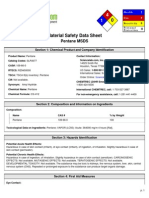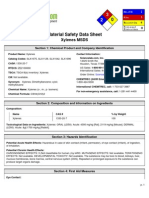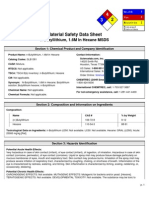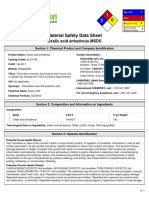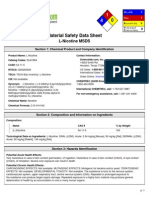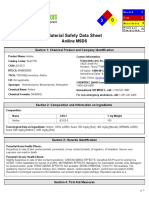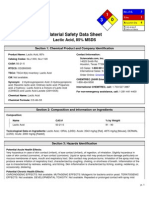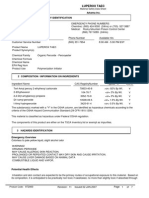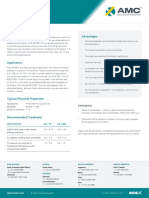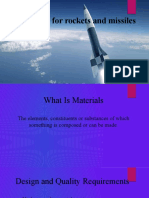Msds Pentane
Msds Pentane
Uploaded by
Muhammad FikriansyahCopyright:
Available Formats
Msds Pentane
Msds Pentane
Uploaded by
Muhammad FikriansyahOriginal Description:
Copyright
Available Formats
Share this document
Did you find this document useful?
Is this content inappropriate?
Copyright:
Available Formats
Msds Pentane
Msds Pentane
Uploaded by
Muhammad FikriansyahCopyright:
Available Formats
p.
1
4
1
0
He a lt h
Fire
Re a c t iv it y
Pe rs o na l
Pro t e c t io n
2
4
0
H
Material Safety Data Sheet
Pentane MSDS
Section 1: Chemical Product and Company Identification
Product Name: Pentane
Catalog Codes: SLP2077
CAS#: 109-66-0
RTECS: RZ9450000
TSCA: TSCA 8(b) inventory: Pentane
CI#: Not available.
Synonym: Amyl Hydride
Chemical Name: Pentane
Chemical Formula: C5-H12
Contact Information:
Sciencelab.com, Inc.
14025 Smith Rd.
Houston, Texas 77396
US Sales: 1-800-901-7247
International Sales: 1-281-441-4400
Order Online: ScienceLab.com
CHEMTREC (24HR Emergency Telephone), call:
1-800-424-9300
International CHEMTREC, call: 1-703-527-3887
For non-emergency assistance, call: 1-281-441-4400
Section 2: Composition and Information on Ingredients
Composition:
Name CAS # % by Weight
Pentane 109-66-0 100
Toxicological Data on Ingredients: Pentane: VAPOR (LC50): Acute: 364000 mg/m 4 hours [Rat].
Section 3: Hazards Identification
Potential Acute Health Effects:
Hazardous in case of skin contact (irritant), of eye contact (irritant), of ingestion, of inhalation. Slightly hazardous in case of
skin contact (permeator).
Potential Chronic Health Effects:
Hazardous in case of ingestion, of inhalation. Slightly hazardous in case of skin contact (sensitizer). CARCINOGENIC
EFFECTS: Not available. MUTAGENIC EFFECTS: Not available. TERATOGENIC EFFECTS: Not available.
DEVELOPMENTAL TOXICITY: Not available. The substance may be toxic to kidneys, the nervous system, liver, skin, central
nervous system (CNS). Repeated or prolonged exposure to the substance can produce target organs damage.
Section 4: First Aid Measures
Eye Contact:
p. 2
Check for and remove any contact lenses. In case of contact, immediately flush eyes with plenty of water for at least 15
minutes. Cold water may be used. WARM water MUST be used. Get medical attention.
Skin Contact:
In case of contact, immediately flush skin with plenty of water. Cover the irritated skin with an emollient. Remove contaminated
clothing and shoes. Wash clothing before reuse. Thoroughly clean shoes before reuse. Get medical attention.
Serious Skin Contact:
Wash with a disinfectant soap and cover the contaminated skin with an anti-bacterial cream. Seek medical attention.
Inhalation:
If inhaled, remove to fresh air. If not breathing, give artificial respiration. If breathing is difficult, give oxygen. Get medical
attention if symptoms appear.
Serious Inhalation:
Evacuate the victim to a safe area as soon as possible. Loosen tight clothing such as a collar, tie, belt or waistband. If
breathing is difficult, administer oxygen. If the victim is not breathing, perform mouth-to-mouth resuscitation. Seek medical
attention.
Ingestion:
If swallowed, do NOT induce vomiting. Never give anything by mouth to an unconscious person. Aspiration hazard if
swallowed- can enter lungs and cause damage. Loosen tight clothing such as a collar, tie, belt or waistband. Get medical
attention.
Serious Ingestion: Not available.
Section 5: Fire and Explosion Data
Flammability of the Product: Flammable.
Auto-Ignition Temperature: 260C (500F)
Flash Points: CLOSED CUP: -49C (-56.2F). (TAG)
Flammable Limits: LOWER: 1.5% UPPER: 7.8%
Products of Combustion: These products are carbon oxides (CO, CO2).
Fire Hazards in Presence of Various Substances:
Extremely flammable in presence of open flames and sparks, of heat. Flammable in presence of oxidizing materials. Non-
flammable in presence of shocks.
Explosion Hazards in Presence of Various Substances:
Risks of explosion of the product in presence of static discharge: Not available. Slightly explosive in presence of heat, of
oxidizing materials. Non-explosive in presence of shocks.
Fire Fighting Media and Instructions:
Flammable liquid, soluble or dispersed in water. SMALL FIRE: Use DRY chemical powder. LARGE FIRE: Use alcohol foam,
water spray or fog. Cool containing vessels with water jet in order to prevent pressure build-up, autoignition or explosion.
Special Remarks on Fire Hazards:
EXTREMELY FLAMMABLE. Vapor may travel considerable distance to source of ignition and flash back.
Special Remarks on Explosion Hazards: Not available.
Section 6: Accidental Release Measures
Small Spill: Absorb with an inert material and put the spilled material in an appropriate waste disposal.
Large Spill:
Flammable liquid. Keep away from heat. Keep away from sources of ignition. Stop leak if without risk. Absorb with DRY earth,
sand or other non-combustible material. Do not touch spilled material. Prevent entry into sewers, basements or confined
p. 3
areas; dike if needed. Be careful that the product is not present at a concentration level above TLV. Check TLV on the MSDS
and with local authorities.
Section 7: Handling and Storage
Precautions:
Keep away from heat. Keep away from sources of ignition. Ground all equipment containing material. Do not ingest. Do not
breathe gas/fumes/ vapor/spray. Wear suitable protective clothing. In case of insufficient ventilation, wear suitable respiratory
equipment. If ingested, seek medical advice immediately and show the container or the label. Avoid contact with skin and
eyes. Keep away from incompatibles such as oxidizing agents.
Storage:
Store in a segregated and approved area. Keep container in a cool, well-ventilated area. Keep container tightly closed and
sealed until ready for use. Avoid all possible sources of ignition (spark or flame). Do not store above 25C (77F).
Section 8: Exposure Controls/Personal Protection
Engineering Controls:
Provide exhaust ventilation or other engineering controls to keep the airborne concentrations of vapors below their respective
threshold limit value. Ensure that eyewash stations and safety showers are proximal to the work-station location.
Personal Protection:
Splash goggles. Lab coat. Vapor respirator. Be sure to use an approved/certified respirator or equivalent. Gloves.
Personal Protection in Case of a Large Spill:
Splash goggles. Full suit. Vapor respirator. Boots. Gloves. A self contained breathing apparatus should be used to avoid
inhalation of the product. Suggested protective clothing might not be sufficient; consult a specialist BEFORE handling this
product.
Exposure Limits:
TWA: 600 STEL: 750 from ACGIH (TLV) [United States] TWA: 1800 STEL: 2210 from ACGIH (TLV) [United States] Consult
local authorities for acceptable exposure limits.
Section 9: Physical and Chemical Properties
Physical state and appearance: Liquid.
Odor: Pleasant. Gasoline-like
Taste: Not available.
Molecular Weight: 72.15g/mole
Color: Colorless.
pH (1% soln/water): Not available.
Boiling Point: 36.1C (97F)
Melting Point: -130C (-202F)
Critical Temperature: 196.6C (385.9F)
Specific Gravity: 0.6262 (Water = 1)
Vapor Pressure: 56.8 kPa (@ 20C)
Vapor Density: 2.49 (Air = 1)
Volatility: Not available.
Odor Threshold: 2.2 ppm
p. 4
Water/Oil Dist. Coeff.: The product is more soluble in oil; log(oil/water) = 3.4
Ionicity (in Water): Not available.
Dispersion Properties: See solubility in water, diethyl ether, acetone.
Solubility:
Partially soluble in diethyl ether, acetone. Very slightly soluble in cold water. Solubility in water: 0.36g/l water @ 16 deg. C.
Solubility in water: 9.9 g in 100 kg water @ 25 deg. C. Solubility in water: 0.04 g in 100 g of water @ 20 deg. C Soluble in
chloroform. Solubility in acetone, benzene, ethanol > 10%
Section 10: Stability and Reactivity Data
Stability: The product is stable.
Instability Temperature: Not available.
Conditions of Instability: Heat, ignition sources, incompatible materials.
Incompatibility with various substances: Reactive with oxidizing agents.
Corrosivity: Non-corrosive in presence of glass.
Special Remarks on Reactivity: Not available.
Special Remarks on Corrosivity: It will attack some forms of plastics, rubber, and coatings.
Polymerization: Will not occur.
Section 11: Toxicological Information
Routes of Entry: Absorbed through skin. Eye contact. Inhalation. Ingestion.
Toxicity to Animals:
WARNING: THE LC50 VALUES HEREUNDER ARE ESTIMATED ON THE BASIS OF A 4-HOUR EXPOSURE. Acute toxicity
of the vapor (LC50): 364000 mg/m3 4 hours [Rat].
Chronic Effects on Humans:
May cause damage to the following organs: kidneys, the nervous system, liver, skin, central nervous system (CNS).
Other Toxic Effects on Humans:
Hazardous in case of skin contact (irritant), of ingestion, of inhalation. Slightly hazardous in case of skin contact (permeator).
Special Remarks on Toxicity to Animals:
Lowest Published Lethal Dose: LCL [Mouse] - Route: Inhalation; Dose 325 gm/m3/2H
Special Remarks on Chronic Effects on Humans: Not available.
Special Remarks on other Toxic Effects on Humans:
Acute Potential Health Effects: Skin: It can cause skin irritaiton with itching, drying erythema, hyperpigmentation, hyperemia,
dermatitis, burning sensations, followed by formation of blisters. It may be aborbed by the skin and cause systemic effects.
Eyes: It is a strong eye irritant. Symptoms may include pain, corneal irritation, and nystagmus Inhalation: It is a mild respiratory
tract (nose, throat, lungs) irritant causing causing coughing, wheezing, and/or shortness of breath. Inhalation exposure to
an airborne concentration of 5,000 ppm for 10 minutes appears to have no ill effect in humans, while 90,000 to 120,000
ppm can affect behavior/central nervous system and cause symptoms of central nervous system depression and narcosis.
Symptoms of central nervous system depression include nausea, headache, weakness, dizzness, excitement, confusion,
lightheadedness, sleepiness, seizures, inability to concentrate, loss of coordination and judgement, coma, and death with
exposure to large amounts. It may also affect the cardiovascular system (dysrhythmias), and metabolism (weight loss/loss of
appetite/anorexia ). Airborne concentration of approximately 130,000 ppm can be fatal by asphyxiation; therefore, there is not
a wide margin of safety concentrations causing central nervous system effects and death. Ingestion: Pulmonary aspiration
of even a small amount can produce acute lung injury, potentially fatal chemical pneumonitis, and hemorrhage. In extreme
cases, respiratory arrest secondary to hypoxia following pneumonitis may occur. It may also affect behavior/central nervous
p. 5
system (symptoms similar to acute inhalation), and cardiovascular system (symptoms similar to acute inhalation). Chronic
Potential Health Effects: Skin: Prolonged or repeated skin contact can cause defatting dermatitis with dryness and cracking.
Long-term dermal exposure may also cause kidney damage. Ingestion or inhalation: Prolonged or repeated ingestion or
inhalation Can cause central nervous system damage. Central nervous system damage symptoms may include numbess,
"pins and needles", and weakness of arms and legs. It may also cause liver damage, adn kidney damage (renal tubular
necrosis, glomerulonephritis, nephritis, proteinuria, hematuria) and may affect metabolism (weight loss).
Section 12: Ecological Information
Ecotoxicity: Not available.
BOD5 and COD: Not available.
Products of Biodegradation:
Possibly hazardous short term degradation products are not likely. However, long term degradation products may arise.
Toxicity of the Products of Biodegradation: The product itself and its products of degradation are not toxic.
Special Remarks on the Products of Biodegradation: Not available.
Section 13: Disposal Considerations
Waste Disposal:
Waste must be disposed of in accordance with federal, state and local environmental control regulations.
Section 14: Transport Information
DOT Classification: CLASS 3: Flammable liquid.
Identification: : Pentane UNNA: 1265 PG: II
Special Provisions for Transport: Not available.
Section 15: Other Regulatory Information
Federal and State Regulations:
Connecticut hazardous material survey.: Pentane Illinois toxic substances disclosure to employee act: Pentane Rhode
Island RTK hazardous substances: Pentane Pennsylvania RTK: Pentane Minnesota: Pentane Massachusetts RTK: Pentane
Massachusetts spill list: Pentane New Jersey: Pentane New Jersey toxic catastrophe prevention act: Pentane California
Director's list of Hazardous Substances: Pentane TSCA 8(b) inventory: Pentane TSCA 4(a) proposed test rules: Pentane
TSCA 8(a) PAIR: Pentane TSCA 8(d) H and S data reporting: Pentane: Effective date: 1/26/94; Sunset Date: 6/30/98
Other Regulations:
OSHA: Hazardous by definition of Hazard Communication Standard (29 CFR 1910.1200). EINECS: This product is on the
European Inventory of Existing Commercial Chemical Substances.
Other Classifications:
WHMIS (Canada):
CLASS B-2: Flammable liquid with a flash point lower than 37.8C (100F). CLASS D-2B: Material causing other toxic effects
(TOXIC).
DSCL (EEC):
HMIS (U.S.A.):
Health Hazard: 2
Fire Hazard: 4
p. 6
Reactivity: 0
Personal Protection: h
National Fire Protection Association (U.S.A.):
Health: 1
Flammability: 4
Reactivity: 0
Specific hazard:
Protective Equipment:
Gloves. Lab coat. Vapor respirator. Be sure to use an approved/certified respirator or equivalent. Wear appropriate respirator
when ventilation is inadequate. Splash goggles.
Section 16: Other Information
References: Not available.
Other Special Considerations: Not available.
Created: 10/10/2005 08:45 PM
Last Updated: 05/21/2013 12:00 PM
The information above is believed to be accurate and represents the best information currently available to us. However, we
make no warranty of merchantability or any other warranty, express or implied, with respect to such information, and we assume
no liability resulting from its use. Users should make their own investigations to determine the suitability of the information for
their particular purposes. In no event shall ScienceLab.com be liable for any claims, losses, or damages of any third party or for
lost profits or any special, indirect, incidental, consequential or exemplary damages, howsoever arising, even if ScienceLab.com
has been advised of the possibility of such damages.
You might also like
- Msds N PentaneDocument6 pagesMsds N Pentanenirmal_subudhiNo ratings yet
- Msds PDFDocument6 pagesMsds PDFToni ChandraNo ratings yet
- Acrolein PDFDocument6 pagesAcrolein PDFzaedmohd50% (2)
- Msds ACROLEINDocument6 pagesMsds ACROLEINAde HadyNo ratings yet
- Msds CresolDocument6 pagesMsds CresolArya Bima Aji KusumaNo ratings yet
- Ethyl Acetate MSDS: Section 1: Chemical Product and Company IdentificationDocument6 pagesEthyl Acetate MSDS: Section 1: Chemical Product and Company IdentificationZachery IngramNo ratings yet
- Msds Ethyl AcetateDocument6 pagesMsds Ethyl AcetateMohammad Taufik Mohar100% (1)
- MSDS Etilen DiaminDocument6 pagesMSDS Etilen DiamindoubleyujeiNo ratings yet
- Msds HeptaneDocument6 pagesMsds Heptanenirmal_subudhiNo ratings yet
- MsdsDocument6 pagesMsdsfrespinosagNo ratings yet
- Msds Dietil EterijijDocument6 pagesMsds Dietil EterijijPriyosetyokoNo ratings yet
- Hydrazine MSDS: Section 1: Chemical Product and Company IdentificationDocument6 pagesHydrazine MSDS: Section 1: Chemical Product and Company IdentificationBayu Pramana PutraNo ratings yet
- (ch3) 2so4Document6 pages(ch3) 2so4arbol100No ratings yet
- MsdsDocument6 pagesMsdsRoby SuheriNo ratings yet
- CikloheksilaminDocument6 pagesCikloheksilaminmicaziv4786No ratings yet
- CikloheksanonDocument7 pagesCikloheksanonmicaziv4786No ratings yet
- Bu-Li MSDSDocument6 pagesBu-Li MSDSPrakash VenkatesanNo ratings yet
- Material Safety Data SheetDocument6 pagesMaterial Safety Data SheetAyie Rawk100% (2)
- Msds TriethanolamineDocument6 pagesMsds TriethanolamineAbubakar AdeniNo ratings yet
- Phenol MSDS: Section 1: Chemical Product and Company IdentificationDocument6 pagesPhenol MSDS: Section 1: Chemical Product and Company IdentificationShabrina Aufar SalmaNo ratings yet
- Msds FenolDocument6 pagesMsds Fenolbenol1987No ratings yet
- Amil AlkoholDocument6 pagesAmil AlkoholJ FadliNo ratings yet
- Potassium Hydroxide. 0.5N (Alcoholic) MSDS: Section 1: Chemical Product and Company IdentificationDocument6 pagesPotassium Hydroxide. 0.5N (Alcoholic) MSDS: Section 1: Chemical Product and Company IdentificationibessemalinaNo ratings yet
- MsdsDocument6 pagesMsdsrashidalghifaryNo ratings yet
- MSDS BenzeneDocument2 pagesMSDS BenzeneYash KayasthNo ratings yet
- Material Safety Data Sheet 2,2,4-Trimethylpentane MSDSDocument6 pagesMaterial Safety Data Sheet 2,2,4-Trimethylpentane MSDSBilly T HoNo ratings yet
- MsdsDocument6 pagesMsdsRizki Adwitiyo 'Dito'No ratings yet
- Asam Oksalat (C2H2O4)Document6 pagesAsam Oksalat (C2H2O4)Dini HandayaniNo ratings yet
- L-Nicotine MSDSDocument6 pagesL-Nicotine MSDSagent4881No ratings yet
- MSDS - AnilinDocument6 pagesMSDS - AnilinsaririskihasibuanNo ratings yet
- Butyl Acrylate MSDS: Section 1: Chemical Product and Company IdentificationDocument6 pagesButyl Acrylate MSDS: Section 1: Chemical Product and Company IdentificationsafaldNo ratings yet
- Msds - Auto I.T KeroseneDocument6 pagesMsds - Auto I.T KeroseneCharith LiyanageNo ratings yet
- Metil AcrilatoDocument6 pagesMetil Acrilatosoulwizard00No ratings yet
- Msds For KeroseneDocument6 pagesMsds For KeroseneMahadeva PrasadNo ratings yet
- MEADocument6 pagesMEAGhifaris VashaNo ratings yet
- Ethylbenzene MSDS PDFDocument6 pagesEthylbenzene MSDS PDFyuanitaNo ratings yet
- Ea MsdsDocument6 pagesEa Msdsapi-263411629No ratings yet
- Msds SalisilatDocument6 pagesMsds SalisilatMartha GamalNo ratings yet
- Msds Benzena PDFDocument6 pagesMsds Benzena PDFIrianto Rizaldi FaturrahmanNo ratings yet
- Butil AlkoholDocument6 pagesButil Alkoholmicaziv4786No ratings yet
- Indikator PPDocument6 pagesIndikator PPNadhil Eka PutraNo ratings yet
- Msds Asam OksalatDocument6 pagesMsds Asam OksalatMitchell SmithNo ratings yet
- Msds Titipan1Document5 pagesMsds Titipan1anitacahyaNo ratings yet
- Lactic Acid MsdsDocument6 pagesLactic Acid MsdsBlue Ofo-ob TJNo ratings yet
- Sodium Ethoxide MSDS: Section 1: Chemical Product and Company IdentificationDocument6 pagesSodium Ethoxide MSDS: Section 1: Chemical Product and Company IdentificationJosé Martín Meza CabillasNo ratings yet
- After a Disaster - Information to Help You and Your Family RecoverFrom EverandAfter a Disaster - Information to Help You and Your Family RecoverNo ratings yet
- First Aid on the Farm: Natural and Conventional TreatmentsFrom EverandFirst Aid on the Farm: Natural and Conventional TreatmentsNo ratings yet
- Hydrogen peroxide uses for the body: 31 5 Minute Remedies! Discover Uses for Hydrogen Peroxide including Mouthwash & Bad Breath, Teeth Whitening, Acne, Ear Wax, Hair, Allergy & Nasal Spray and MOREFrom EverandHydrogen peroxide uses for the body: 31 5 Minute Remedies! Discover Uses for Hydrogen Peroxide including Mouthwash & Bad Breath, Teeth Whitening, Acne, Ear Wax, Hair, Allergy & Nasal Spray and MORERating: 5 out of 5 stars5/5 (1)
- Georgia Pest Management Handbook: 2021 Home and Garden EditionFrom EverandGeorgia Pest Management Handbook: 2021 Home and Garden EditionEmily CabreraNo ratings yet
- Improvised Munitions Handbook – Learn How to Make Explosive Devices & Weapons from Scratch (Warfare Skills Series): Illustrated & With Clear InstructionsFrom EverandImprovised Munitions Handbook – Learn How to Make Explosive Devices & Weapons from Scratch (Warfare Skills Series): Illustrated & With Clear InstructionsRating: 3.5 out of 5 stars3.5/5 (7)
- Hydrogen Peroxide Elixir: Top Extraordinary Uses of Hydrogen Peroxide for Beauty, Health, Wellness, Glowing Hair and Total Body HealingFrom EverandHydrogen Peroxide Elixir: Top Extraordinary Uses of Hydrogen Peroxide for Beauty, Health, Wellness, Glowing Hair and Total Body HealingRating: 3 out of 5 stars3/5 (2)
- Optigal’s Q & A for the CLRE: Contact Lens Registry Exam Questions Basic Certification - NCLEFrom EverandOptigal’s Q & A for the CLRE: Contact Lens Registry Exam Questions Basic Certification - NCLENo ratings yet
- Essential First Aid: Life-Saving Techniques for EveryoneFrom EverandEssential First Aid: Life-Saving Techniques for EveryoneNo ratings yet
- Eczema No More: The Complete Guide to Natural Cures for Eczema and a Holistic System to End Eczema & Clear Your Skin Naturally & PermanentlyFrom EverandEczema No More: The Complete Guide to Natural Cures for Eczema and a Holistic System to End Eczema & Clear Your Skin Naturally & PermanentlyRating: 5 out of 5 stars5/5 (1)
- Human Resources: Cholida Imaysari Muhammad Iqbal Syaipuddin ZuhriDocument11 pagesHuman Resources: Cholida Imaysari Muhammad Iqbal Syaipuddin ZuhriMuhammad FikriansyahNo ratings yet
- Tulsion A 23SMDocument2 pagesTulsion A 23SMMuhammad FikriansyahNo ratings yet
- TML 10 DDocument2 pagesTML 10 DMuhammad FikriansyahNo ratings yet
- MSDS TaecDocument7 pagesMSDS TaecMuhammad FikriansyahNo ratings yet
- The Leaves of Multi-Leaf Springs Are Subjected ToDocument25 pagesThe Leaves of Multi-Leaf Springs Are Subjected ToBodkarNo ratings yet
- E Tender 20-03-18Document132 pagesE Tender 20-03-18gomathi ShankarNo ratings yet
- Cold Front - Vol. 14 No. 3, 2014 NewsletterDocument13 pagesCold Front - Vol. 14 No. 3, 2014 NewsletterYutt WattNo ratings yet
- NH MSDS BlackDocument6 pagesNH MSDS BlackBlack Flag CommunicationsNo ratings yet
- WDFDocument18 pagesWDFJose OrtizNo ratings yet
- CompEx GuideDocument22 pagesCompEx GuideFederico MaggiNo ratings yet
- Lista 15-01-2024 Drogueria BaronDocument198 pagesLista 15-01-2024 Drogueria Baronangel duranNo ratings yet
- Amc CR 650 PDSDocument1 pageAmc CR 650 PDSShooWin Allen JohnNo ratings yet
- Features:: Transport DimensionsDocument2 pagesFeatures:: Transport DimensionsshawnNo ratings yet
- Che121l Experiment 1 Partial Molar VolumesDocument6 pagesChe121l Experiment 1 Partial Molar VolumesKim Lloyd A. Barrientos100% (1)
- Papper Asam BasaDocument3 pagesPapper Asam BasaAsrel05No ratings yet
- Sem 1 - EVS SyllabusDocument9 pagesSem 1 - EVS SyllabusSmitali UkeyNo ratings yet
- Plastmix WPDocument2 pagesPlastmix WPmohab hakimNo ratings yet
- Bronze-ANSI-Gate-Globe-Check-and-Ball-Valves KITZDocument32 pagesBronze-ANSI-Gate-Globe-Check-and-Ball-Valves KITZindika sunarkoNo ratings yet
- Dokumen - Tips 2 Myanmar Agriculture Sector 3 The Most Important CropsDocument69 pagesDokumen - Tips 2 Myanmar Agriculture Sector 3 The Most Important CropsHan Htun OoNo ratings yet
- AntidotesDocument29 pagesAntidotesjyothisahadevanNo ratings yet
- 85% High Alumina Refractory Brick Specs: Brand Properties DL-87WDocument2 pages85% High Alumina Refractory Brick Specs: Brand Properties DL-87WHasan Ash100% (1)
- Analisis Energi Dan Eksergi Pada Produksi Biodiesel Berbahan Baku Cpo (Crude Palm Oil)Document115 pagesAnalisis Energi Dan Eksergi Pada Produksi Biodiesel Berbahan Baku Cpo (Crude Palm Oil)Baim ManurungNo ratings yet
- Organic Coated Steel: ArcelorDocument37 pagesOrganic Coated Steel: ArcelordangmiuNo ratings yet
- Presentation HIC DamageDocument5 pagesPresentation HIC DamageSaqib KhanNo ratings yet
- Briggs Stratton 1100 SeriesDocument32 pagesBriggs Stratton 1100 Seriesmkala83100% (1)
- Atul LTDDocument6 pagesAtul LTDpreeti kumariNo ratings yet
- UNS S32760 Superduplex Stainless Steel For Wet FGD Air Pollution SystemsDocument15 pagesUNS S32760 Superduplex Stainless Steel For Wet FGD Air Pollution SystemsdsoNo ratings yet
- 13.lucas Meyer Cosmetics CW Marketing BrochureDocument4 pages13.lucas Meyer Cosmetics CW Marketing BrochureHans Noble100% (1)
- HDK N-20, TDSDocument2 pagesHDK N-20, TDShery siregarNo ratings yet
- Bank Soal TK Unri: Termodinamika Teknik Kimia IDocument3 pagesBank Soal TK Unri: Termodinamika Teknik Kimia IYulia Nurul Ma'rifahNo ratings yet
- KleenRite Edge 100-3Document21 pagesKleenRite Edge 100-3Nestor Marquez-Diaz100% (1)
- Materials For Rockets and MissilesDocument18 pagesMaterials For Rockets and MissilesDiamoundDomeProgram R&D100% (1)
- Hydrogen Class 11Document22 pagesHydrogen Class 11Ritika MulchandaniNo ratings yet
- Basics of Light Transmitting ConcreteDocument8 pagesBasics of Light Transmitting ConcreteMaharNadirAliNo ratings yet
